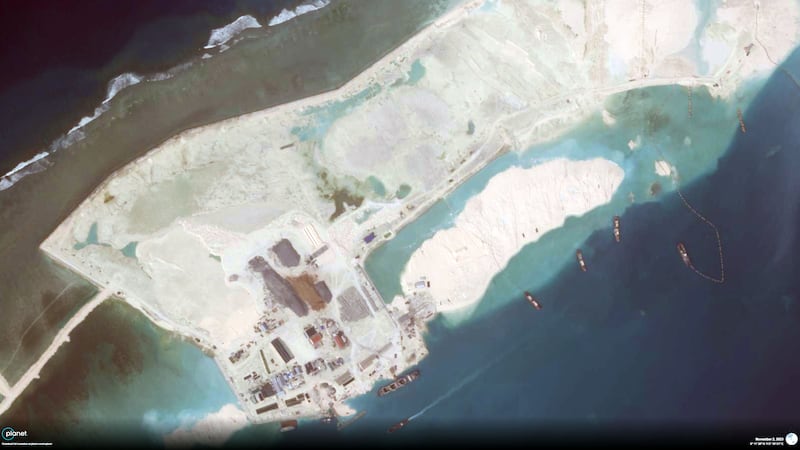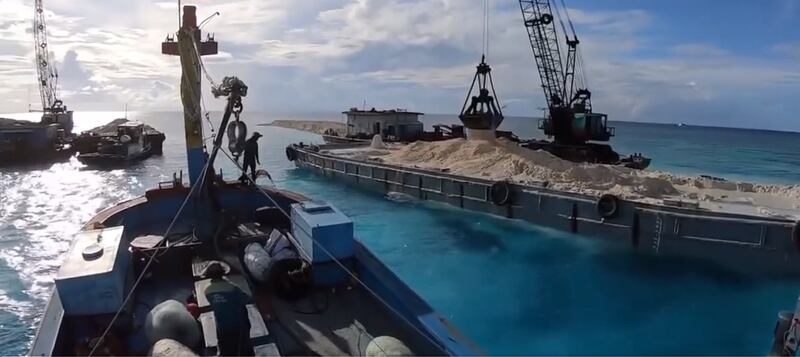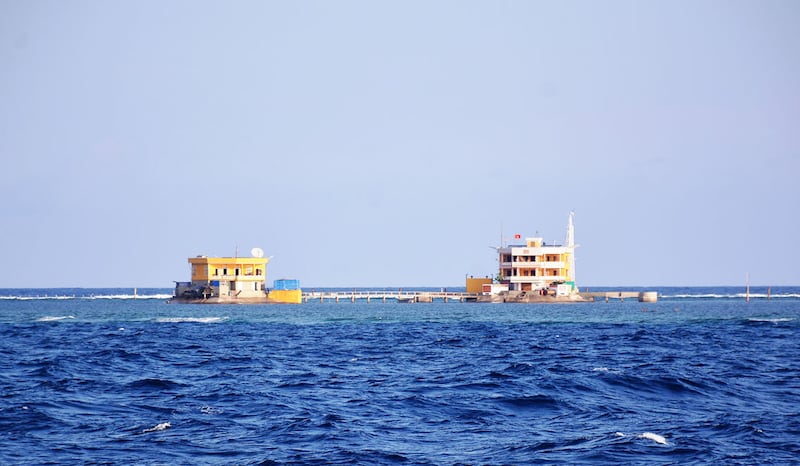Vietnam has been developing a reef in the Spratly Islands in the South China Sea, expanding its reclaimed area more than four times in less than a year, satellite imagery shows.
Dredging and landfill has been carried out at Barque Canada Reef since the end of 2021 but gathered pace in the past year, according to satellite data obtained by Radio Free Asia.
As of early November 2023, the total landfill area of the main feature and two smaller ones amounted to nearly 1 square kilometer, or 247 acres, compared to 58 acres at the end of 2022. The presence of dredgers and barges suggests construction work is underway at the reef.
It is still, however, much smaller than any of China’s so-called Big Three artificial islands — Fiery Cross Reef, Mischief Reef and Subi Reef — that the country developed and fully militarized.

The Asia Maritime Transparency Initiative (AMTI) think tank at the Center for Strategic and International Studies based in Washington, D.C., said in December last year that Vietnam has accelerated reclamation work in the South China Sea, bringing the total of new land in the last 10 years to 540 acres.
Apart from Barque Canada Reef, works are also being carried out on several other features, such as Pearson Reef, Namyit Reef, Tennent Reef and Sand Cay.
Even with the new reclamation in 2023, it is still far less than the 3,200 acres of land created by China between 2013 and 2016.
Chinese think tank the South China Sea Probing Initiative alleged in September that Hanoi may be "building a second airfield" on the Barque Canada. RFA could not independently verify this claim.
AMTI’s Greg Poling said he was not aware of the rumors about the second runway and “can’t see anything at a glance that obviously looks like a runway” in the latest satellite images.
Until now, Vietnam only has a runway on the Spratly Islands, or Truong Sa Lon in Vietnamese, which was doubled in length several years ago to accommodate medium-sized military aircraft.
Big potential
At the main feature in the northeast of the reef, dozens of ships and at least two large dredgers were visible in an image provided by the U.S. satellite imaging company Planet Labs on Nov. 2.
Video clips believed to be recorded by workers and circulated on social media show large barges bringing sand and construction materials to the reclamation area.

Several Vietnamese military sources, who wished to stay anonymous because they are not authorized to speak to foreign media, told RFA that the Vietnamese government and army “put a great importance on the development” of Barque Canada Reef.
“The entire reef is roughly 50km2 [12,355 acres]. It definitely has big potential,” the source said.
Tom Shugart, an adjunct senior fellow with the Defense Program at the Center for a New American Security in Washington, D.C., said that “another base and runway would give Vietnam a position on the other side of China’s Big Three islands, bracketing them to some degree.”
“It would certainly help them get better coverage and capacity within the area,” Shugart told RFA, adding that “it’s hard to know much more until we see how big the facility ends up being.”
Vietnamese netizens have also taken a keen interest in the reef, which is also claimed by China, Malaysia, the Philippines, and Taiwan, generating an intense discussion on internet defense forums about how a new runway on the reef could strengthen Vietnam’s defense capability in the disputed waters.
Meanwhile, Chinese netizens point to " lost opportunities" associated with the reef, called Bai Jiao in Mandarin, which is not only strategically located in the middle of the South China Sea but also is " ten times larger than Mischief Reef."
Vietnam’s ‘Fishing Boat’ in the sea
Barque Canada Reef is called Bai Thuyen Chai, or Fishing Boat Reef, in Vietnamese because of its shape resembling a shipping vessel.
Vietnam’s Navy claimed it first occupied Barque Canada in 1978 but had to withdraw soon afterward because of “unsustainable conditions.” They came back ten years later to set up three outposts on the reef, which have now become permanent buildings with facilities for the stationed troops and visiting fishermen, and even a “cultural center.”
The outposts are outside the current reclamation areas.

Vietnamese authorities have been promoting sustainable development on the features in the South China Sea, including the Barque Canada Reef.
An order from the Ministry of Agriculture and Rural Development says 200m2 of greenhouses will be set up this year on the Barque Canada reef for vegetable farming, and soldiers will be trained on how to raise ducks.
In a directive issued on April 3, 2023, the Vietnamese government set the objective of "determining areas for reclamation and building artificial islands in order to develop the country's economy and society."
Hanoi currently controls 27 features in the South China Sea, according to AMTI.
The ongoing reclamation “represents a major move toward reinforcing its position in the Spratlys,” the think tank said in the December 2022 analysis.
